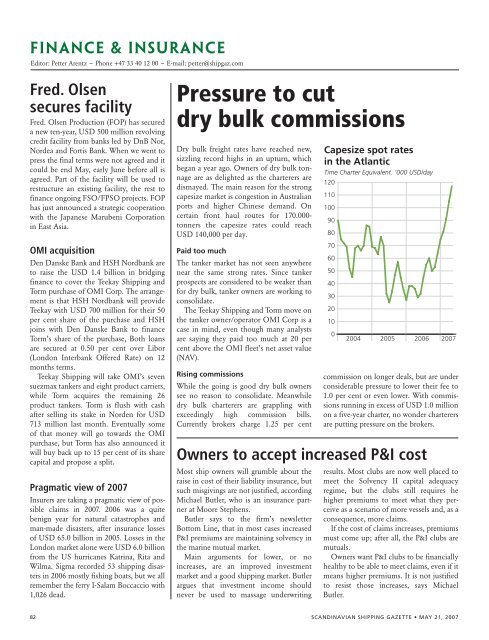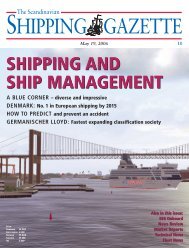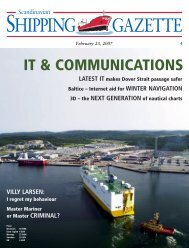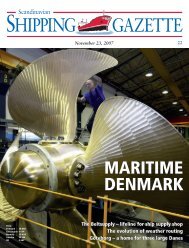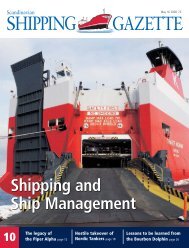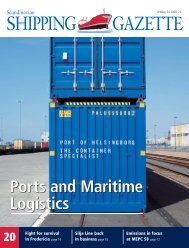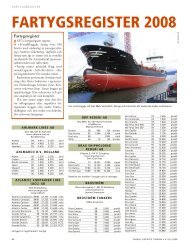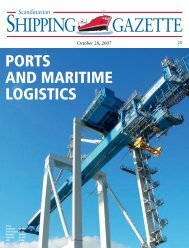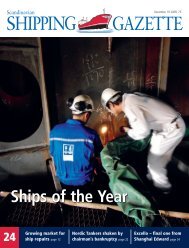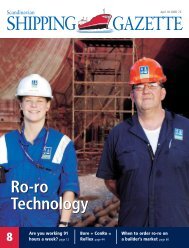SSG No 10 - Shipgaz
SSG No 10 - Shipgaz
SSG No 10 - Shipgaz
Create successful ePaper yourself
Turn your PDF publications into a flip-book with our unique Google optimized e-Paper software.
finANCE & INSURANCE<br />
Editor: Petter Arentz ~ Phone +47 33 40 12 00 ~ E-mail: petter@shipgaz.com<br />
Fred. Olsen<br />
secures facility<br />
Fred. Olsen Production (FOP) has secured<br />
a new ten-year, USD 500 million revolving<br />
credit facility from banks led by DnB <strong>No</strong>r,<br />
<strong>No</strong>rdea and Fortis Bank. When we went to<br />
press the final terms were not agreed and it<br />
could be end May, early June before all is<br />
agreed. Part of the facility will be used to<br />
restructure an existing facility, the rest to<br />
finance ongoing FSO/FPSO projects. FOP<br />
has just announced a strategic cooperation<br />
with the Japanese Marubeni Corporation<br />
in East Asia.<br />
OMI acquisition<br />
Den Danske Bank and HSH <strong>No</strong>rdbank are<br />
to raise the USD 1.4 billion in bridging<br />
finance to cover the Teekay Shipping and<br />
Torm purchase of OMI Corp. The arrangement<br />
is that HSH <strong>No</strong>rdbank will provide<br />
Teekay with USD 700 million for their 50<br />
per cent share of the purchase and HSH<br />
joins with Den Danske Bank to finance<br />
Torm’s share of the purchase, Both loans<br />
are secured at 0.50 per cent over Libor<br />
(London Interbank Offered Rate) on 12<br />
months terms.<br />
Teekay Shipping will take OMI’s seven<br />
suezmax tankers and eight product carriers,<br />
while Torm acquires the remaining 26<br />
product tankers. Torm is flush with cash<br />
after selling its stake in <strong>No</strong>rden for USD<br />
713 million last month. Eventually some<br />
of that money will go towards the OMI<br />
purchase, but Torm has also announced it<br />
will buy back up to 15 per cent of its share<br />
capital and propose a split.<br />
Pragmatic view of 2007<br />
Insurers are taking a pragmatic view of possible<br />
claims in 2007. 2006 was a quite<br />
benign year for natural catastrophes and<br />
man-made disasters, after insurance losses<br />
of USD 65.0 billion in 2005. Losses in the<br />
London market alone were USD 6.0 billion<br />
from the US hurricanes Katrina, Rita and<br />
Wilma. Sigma recorded 53 shipping disasters<br />
in 2006 mostly fishing boats, but we all<br />
remember the ferry I-Salam Boccaccio with<br />
1,026 dead.<br />
Pressure to cut<br />
dry bulk commissions<br />
Dry bulk freight rates have reached new,<br />
sizzling record highs in an upturn, which<br />
began a year ago. Owners of dry bulk tonnage<br />
are as delighted as the charterers are<br />
dismayed. The main reason for the strong<br />
capesize market is congestion in Australian<br />
ports and higher Chinese demand. On<br />
certain front haul routes for 170.000tonners<br />
the capesize rates could reach<br />
USD 140,000 per day.<br />
Paid too much<br />
The tanker market has not seen anywhere<br />
near the same strong rates. Since tanker<br />
prospects are considered to be weaker than<br />
for dry bulk, tanker owners are working to<br />
consolidate.<br />
The Teekay Shipping and Torm move on<br />
the tanker owner/operator OMI Corp is a<br />
case in mind, even though many analysts<br />
are saying they paid too much at 20 per<br />
cent above the OMI fleet’s net asset value<br />
(NAV).<br />
Rising commissions<br />
While the going is good dry bulk owners<br />
see no reason to consolidate. Meanwhile<br />
dry bulk charterers are grappling with<br />
exceedingly high commission bills.<br />
Currently brokers charge 1.25 per cent<br />
Most ship owners will grumble about the<br />
raise in cost of their liability insurance, but<br />
such misgivings are not justified, according<br />
Michael Butler, who is an insurance partner<br />
at Moore Stephens.<br />
Butler says to the firm’s newsletter<br />
Bottom Line, that in most cases increased<br />
P&I premiums are maintaining solvency in<br />
the marine mutual market.<br />
Main arguments for lower, or no<br />
increases, are an improved investment<br />
market and a good shipping market. Butler<br />
argues that investment income should<br />
never be used to massage underwriting<br />
Capesize spot rates<br />
in the Atlantic<br />
Time Charter Equivalent. ‘000 USD/day<br />
commission on longer deals, but are under<br />
considerable pressure to lower their fee to<br />
1.0 per cent or even lower. With commissions<br />
running in excess of USD 1.0 million<br />
on a five-year charter, no wonder charterers<br />
are putting pressure on the brokers.<br />
Owners to accept increased P&I cost<br />
results. Most clubs are now well placed to<br />
meet the Solvency II capital adequacy<br />
regime, but the clubs still requires he<br />
higher premiums to meet what they perceive<br />
as a scenario of more vessels and, as a<br />
consequence, more claims.<br />
If the cost of claims increases, premiums<br />
must come up; after all, the P&I clubs are<br />
mutuals.<br />
Owners want P&I clubs to be financially<br />
healthy to be able to meet claims, even if it<br />
means higher premiums. It is not justified<br />
to resist those increases, says Michael<br />
Butler.<br />
82 SCANDINAVIAN SHIPPING GAZETTE • MAY 21, 2007<br />
120<br />
1<strong>10</strong><br />
<strong>10</strong>0<br />
90<br />
80<br />
70<br />
60<br />
50<br />
40<br />
30<br />
20<br />
<strong>10</strong><br />
0<br />
2004<br />
2005<br />
2006<br />
2007


